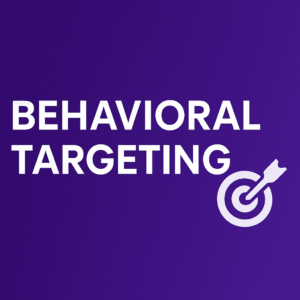What is Behavioral Targeting?
Behavioral targeting is a digital marketing strategy that leverages data about users’ online behaviors to tailor content advertisements, and experiences to individual preferences and needs. Instead of using broad demographics like age, gender, or location, behavioral targeting focuses on actions — such as websites visited, products viewed, links clicked, and even time spent on particular pages.
By analyzing these behaviors, marketers can predict what a user might be interested in next and serve them content that feels personal, timely, and valuable. This approach not only enhances user engagement but also drives higher conversion rates compared to generic marketing efforts.
How Does Behavioral Targeting Work?
Behavioral targeting works through the collection and analysis of user data, typically gathered via:
-
Cookies: Small data files stored in a user’s browser that track their activities across sites.
-
Tracking Pixels: Invisible images on web pages that capture user interactions.
-
Browser Fingerprinting: Techniques that create a unique profile of a user’s device and behavior patterns.
Once the data is collected, sophisticated algorithms segment users into distinct profiles or personas based on shared behaviors and interests. This enables marketers to:
-
Show relevant ads to users based on previous interactions.
-
Personalize website content dynamically.
-
Recommend products or services tailored to browsing history.
-
Trigger emails or notifications based on user actions.
For example, if a visitor frequently browses fitness equipment, behavioral targeting allows a brand to show them special offers on gym gear — increasing the likelihood of a purchase.
The Benefits of Behavioral Targeting
1. Improved Personalization
Users today expect personalized experiences. Behavioral targeting ensures that every interaction — whether it’s an ad, email, or on-site content — feels curated for the individual, enhancing satisfaction and brand loyalty.
2. Higher Conversion Rates
Personalized marketing messages resonate more strongly, often leading to higher click-through rates (CTR) and conversions. When users see offers that align with their interests, they’re more likely to engage and buy.
3. Efficient Use of Marketing Budget
By focusing on users who are most likely to convert, businesses can allocate their marketing spend more effectively, reducing waste on uninterested audiences.
4. Enhanced Customer Insights
Behavioral data provides rich insights into customer preferences, habits, and decision-making processes. This information can guide product development, content strategies, and overall business growth.
Types of Behavioral Targeting
Behavioral targeting can be applied across various marketing channels:
-
Website Personalization: Tailoring website content in real time based on user behavior.
-
Email Marketing: Sending personalized emails triggered by specific actions like cart abandonment or previous purchases.
-
Retargeting Ads: Displaying ads to users who have previously interacted with your site but didn’t convert.
-
Content Recommendations: Suggesting blogs, articles, or videos that align with past consumption patterns.
Ethical Considerations and Data Privacy
With great power comes great responsibility. While behavioral targeting offers undeniable advantages, it’s essential to approach it ethically. Consumers are increasingly concerned about data privacy, especially with regulations like GDPR and CCPA in place.
Brands must:
-
Be transparent about data collection practices.
-
Offer users the ability to opt in or opt out of tracking.
-
Ensure data security and compliance with relevant privacy laws.
Ethical practices not only build trust but also ensure long-term relationships with customers.
Future Trends in Behavioral Targeting
As technology evolves, behavioral targeting is becoming even more sophisticated. With advancements in AI and machine learning, marketers can predict user needs with greater accuracy. Additionally, the rise of cookieless tracking solutions is reshaping how data is gathered while respecting privacy standards.
Moreover, integrating behavioral data with other data types — like contextual or demographic data — can create even richer, multi-dimensional targeting strategies.
Ready to Leverage Behavioral Targeting?
Behavioral targeting is no longer just a nice-to-have — it’s a must-have for any brand serious about digital marketing success. By understanding and implementing behavioral targeting, businesses can deliver personalized, relevant experiences that drive engagement, boost conversions, and build lasting customer relationships.

Frequently Asked Questions
Behavioral targeting focuses on users’ online actions, such as browsing history, clicks, and engagement patterns, to deliver personalized content. In contrast, demographic targeting segments audiences based on factors like age, gender, income, and location. While demographic targeting provides general audience profiles, behavioral targeting offers a deeper, real-time understanding of user interests and intent.
Yes, when implemented responsibly, behavioral targeting is both ethical and compliant. Brands must follow data privacy regulations like GDPR and CCPA, ensuring transparency, user consent, and data protection. Ethical practices include clear privacy policies, opt-in options for data tracking, and secure data storage to safeguard user information.
Behavioral targeting enhances marketing performance by delivering highly relevant and personalized experiences. It leads to higher click-through rates, better engagement, increased conversions, and more efficient use of marketing budgets. By focusing on user behavior, brands can connect with the right audience at the right time with the right message.
To figure out which creatives, audiences, and channels are really helping to lower your Customer Acquisition Cost (CAC), it constantly sifts through data from thousands of touchpoints. When it spots something that’s not performing as well as it should, it quickly shifts spending to what’s working best.
Absolutely! Behavioral targeting isn’t just for large enterprises. Small and medium-sized businesses can leverage behavioral data through affordable tools like retargeting ads, personalized email campaigns, and website personalization. These strategies help smaller brands compete effectively by reaching potential customers with tailored content that drives action.

Book a Strategy Call
Author
George is the CEO of Briefstorm Digital and a AI marketing expert. When not planning strategies or implement AI techincs, he hits the gym and plays sports.
Recent Posts

